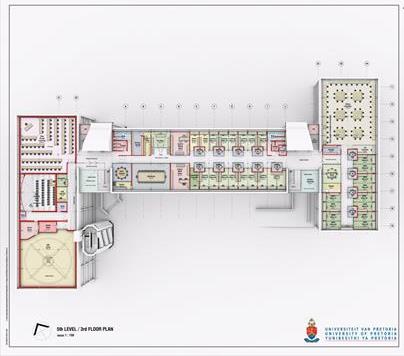Posted on March 05, 2014
“Turning text into insights and making abstract concepts concrete,” Prof Ronny Webber-Youngman, Head of the Department of Mining Engineering, says about his new project that will establish the UP as the leading, state of the art institute in mining engineering on the African continent.
The Kumba Virtual Reality Centre will form one leg on the western side of a whole new floor of 1 600 square meters, which will be built on top of the existing Mineral Science building on Hatfield Campus. The middle section will house office space for the Mining Engineering Department’s senior staff (complete with individual meeting rooms, a boardroom and archive) and the third leg, forming the eastern flank, will house a laboratory and research staff as part of the Mining Resilience Research Institute (MRRI). A disabled-friendly entrance will be available on the northern side between the VR Centre and the senior staff section.
Kumba Iron Ore, a member of the Anglo American plc group, is the sponsor for the virtual reality section, which will consist of a state of the art 75-seat lecture hall, a 3D cinematic theatre with a curved screen and the cylinder based room, which already stands to be known as the ‘3D 360’room. The three spaces will contribute to a revolutionary way of mining education. The 4.5m high 3D 360 ‘room’ of 78.6 square meters will have a diameter of approximately 10 meters, surround sound and five overhead projectors that will take students right into the hearts of mines—whether speeding down a shaft or walking along tunnels- as well as expose them to other facets of mining engineering. Apparently the effect is so real that people get motion sickness, although they are motionless.
With this contemporary teaching approach in a three-dimensional environment, the different packages (such as hazard awareness and mine designing) will be co-developed and delivered in collaboration with a Pretoria based Virtual Reality simulation company Simulated Training Solutions (STS). With instruction on such a realistic basis, difficulties that are common in the mining industry such as accidents en bad planning and design will be addressed and understood more easily and above all experienced on a personal level. “The VR centre will become a mine by itself,” Prof Webber-Youngman stated.
The building of this exciting R50 million project (of which the Kumba VR centre will cost R18 million) will start in April under the management of Mr Johann Louw, who was contracted from the industry for the position. The impressive structure of steel, concrete and glass on top of the Mineral Science building will hopefully be completed by early next year. The infrastructure is designed to withstand power cuts or even minor fluctuations.
Mining industry financial support has become part and parcel of the strategic plan of the department. Without industry support interventions like mentioned before will not be possible. At the moment there are approximately 400 mining engineering students, whereas in the past it was rarely more than 70. The current staff complement is 30 staff members, which would not have been possible if it was not for the mining industry support. Currently there are two chairs in the department. The Sasol Chair in Safety Health and Environment and the Harmony Chair in Rock Engineering and Numerical Modelling. The establishment of the MRRI is made possible through the generous support of Sasol Mining and currently being established by the project manager Mr. Rob Smart. Eight post-graduate students have been appointed as academic instructors/assistants and fill their all-rounder positions fondly referred to as the departments’ own ‘shift-bosses’ .

Copyright © University of Pretoria 2024. All rights reserved.
Get Social With Us
Download the UP Mobile App